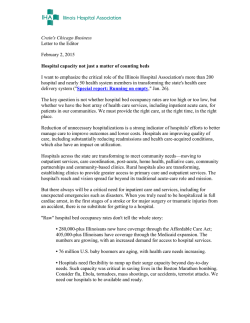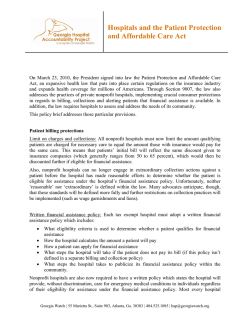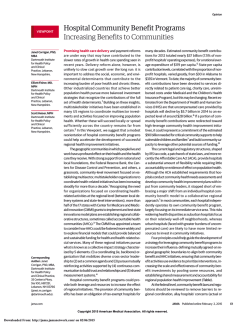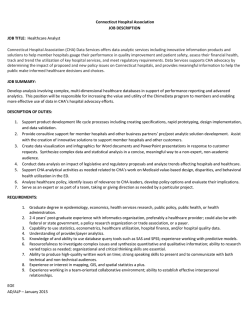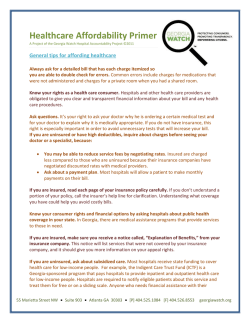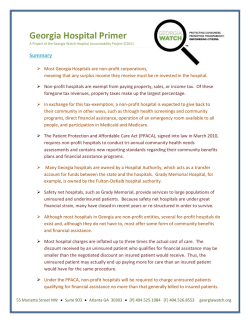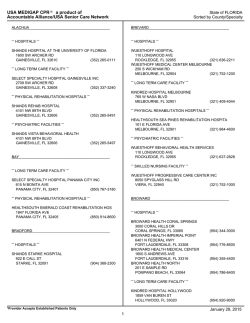
here
Division of Practitioner Data Bank Monitoring National Practitioner Data Bank Hospital Reporting of Adverse Actions Taken Against Clinical Privileges: Summary of Discussions Introduction The he Division of Practitioner Data Banks (DPDB) of the Health Resources and Services Administration (HRSA) is responsible for monitoring ing hospital compliance with required querying and reporting to the National Practitioner Data Bank (NPDB or “Data Bank”) Bank”). To that end, in 2012, DPDB participated in discussion groups with stakeholders to discuss perspectives regarding hospital use of the Data Bank for querying and reporting. DPDB compliance officers spoke with with: Members embers of the NPDB Executive Committee Committee; Members embers of the American Health Lawyers Association Association; Members embers of the Health Care Compliance Association Association; Members embers of the American Society of Risk Managers Managers; Local ocal medical staff services professionals professionals; and Members of the National Association Medical Staff Services Services. In addition, DPDB staff met with representatives of a large teaching health system to learn about its system and relationship with the Data Bank. The meeting documented what certain hospitals do that impacts cts how they use the Data Bank. The goal of the meeting was to gain a deeper understanding of hospital policies, procedures, and practices in order to develop a meaningful approach to monitor hospital use of the Data Bank. Findings from Qualitative Discu Discussion Groups A number of themes arose from the various discussions, which are summarized below. To capture the breadth of the conversation, key points made by some of the individual participants are included in the summary. These comments were made by the individual participants, and do not necessarily reflect the views of HRSA. These comments also do not necessarily reflect the views of all participants. Hospital Systems and Business Models are Evolving PARTICIPANT FEEDBACK How hospitals function is not the same now as it was 20 years ago when the statutes governing the Data Bank were written. Some of the changes relate to the use of employed physicians, contracts with physician groups, and the use of locum tenens. Additional changes involve how ho hospitals spitals engage with non-physician physician practitioners and the relationship of those practitioners with formal peer review processes. In addition, state laws affecting hospital reporting of certain actions have evolved, which may run counter to the Data Bank’s intent. 1 There are lingering questions about whether The Joint Commission (TJC) standards support the automatic termination of clinical privileges without due process when a physician is terminated from employment at a hospital. Physicians are terminated through employment before a potential issue ever reaches the formal peer review process. From a Human Resources (HR) perspective, they just terminate the physician. One stakeholder suggested that, perhaps, HR actions should be reportable. There sometimes is some confusion regarding whether exploring concerns about credentials is an HR responsibility or a medical staff services responsibility. Some hospitals are still attempting to clearly define such roles and responsibilities. If there is a contract with a physician who is terminated, and through the contract their privileges automatically terminate, there may never be a professional review action. Thus, there is no reportable event. Is this accurate, or do physicians have rights in both hemispheres? This is still relatively new territory regarding contracts between hospital and practitioners. There is concern that the Data Bank would get into the business of telling hospitals what kinds of actions they should be taking, instead of educating and monitoring hospitals regarding the reportability to the Data Bank of actions taken by the hospital. It is difficult for hospitals in a dynamic environment to comply with a set of rather static rules. In some states, physicians have learned how to skirt the system by resigning before certain reporting triggers are met. As physicians retire, younger medical staff are assuming leadership positions now, and they are less tolerant of some things the “elder statesmen” have put up with, or maybe were complicit with. This may result in more openness to submit reports. Guidance is needed regarding how Data Bank regulations apply to “newer animals” of health care delivery mechanisms. Accountable Care Organizations were cited as an example of a “new animal.” When hospitals use locum tenens, they are unwilling to invest time and energy to determine why the physician is incompetent. As one stakeholder noted, “You don’t care what happens to that person. You just want somebody else here tomorrow.” Health care reform is going to change how hospitals do peer review and how they assess trouble spots are in the delivery of care. It is unclear what that means under the current Data Bank requirements. Roles, Responsibilities, and Functions are Evolving PARTICIPANT FEEDBACK In addition to changes that impact health care delivery models, internal administration and management functions within health care systems are also evolving. This is creating potential overlap between medical staff services personnel, human resources personnel, and compliance officers. Some hospitals are seeing the need to break down silos. Questions remain about how to improve effectiveness and efficiency in a changing culture. Hospitals need processes to trigger when compliance (fraud) identifies something important that medical staff services (quality of care) needs to know, and vice versa. Compliance officers are very good at conducting investigations, and this could be a resource for the medical staff/physician peer review processes. There are frequent overlaps between issues. For example, there are emerging connections being made between quality of care issues and false claims. There is a need to educate board leadership at hospitals so they understand the multiple levels of responsibilities for medical staff services and compliance (fraud and abuse). Compliance officers continue to invest energy and resources in board education. 2 A lack of communication in a hospital between HR and medical staff could lead to serious consequences. A recent example involved HR terminating a physician, but the physician still showed up three months later on the medical staff directory. If the hospital was using the Continuous Query feature of the NPDB and had not removed the physician from their enrollment list, it would have resulted in a breach of confidentiality on the part of the hospital. As long as a determination can be made to handle a potential issue as a management issue under a contract, and not through the medical staff review process that is what will generally continue to happen. The question of how much compliance officers need to know and be involved with quality of care issues is coming up more frequently. There have been a few Corporate Integrity Agreements that are putting compliance officers in new roles and there has not been a lot of guidance on how to make this work. These are instituted by HHS OIG, mostly in matters of fraud, and there seem to be some cases where there is a connection between fraud and quality of care, which is relatively new territory. Hospital components (compliance, risk management, medical staff services, human resources, etc.) can be very territorial, especially with issues involving physicians, and individual egos get involved, as well. In some hospitals, there is a “veil” shielding peer review. However, as individuals fill different roles and serve on committees with others, information and knowledge are shared in helpful ways. One individual commented, “I can’t imagine doing my job as the compliance officer without having all of that knowledge [from the peer review committee] and being involved in that information.” In one hospital, medical and compliance staff are all within one physical area, and staff are constantly collaborating. For instance, when there are changes to bylaws or policies draft by the medical staff services office, the compliance officer is the first to review them. Compliance officers play a key role in assuring there is an effective process for managing quality issues, but they are not necessarily involved in the quality management functions. Compliance departments are at different levels of maturity in various hospitals, and as roles evolve, so will the role of the compliance staff. In many cases, the quality issue is new to compliance, and the medical staff services office is still learning about the role of compliance. In some hospitals, there is limited intersection between compliance and peer review. At times, the Data Bank reporting requirements lead to tensions between the medical staff services office and hospital administration. Medical staff professionals try to keep reporting requirements in front of people who are tasked with following the rules. Strong Credentialing Processes are in Place PARTICIPANT FEEDBACK Credentialing processes used by hospitals are much more robust now, so physicians with questionable backgrounds are often not considered for clinical privileges. Some hospitals (for instance, large university-based teaching hospitals) are in a position to invite candidates without having an open invitation process. This gives them an opportunity to carefully review credentials and experience before considering the candidates. Many hospitals are using a pre-application process that examines qualifications before a formal application is submitted. Most hospitals have a well-defined credentialing process that is transparent for all candidates. Some hospitals have set very clear and transparent processes in place so there is no confusion about when an application process begins and when an investigation is taking place. 3 Hospitals advise candidates to withdraw applications if they see any problem with either employment or clinical privilege going through. This results in a low number of denials of clinical privileges for cause. There is a strong relationship between the medical staff coordinators and the chief medical officer or department chairs. Any red flags in the credentialing process are shared with these managers and they guide the process from there. Infrequent Reporters Need Help PARTICIPANT FEEDBACK Because reporting is so infrequent, and the process that results in reporting takes so long, the personnel responsible for reporting need refreshers and reminders about what, when, and how to report to the Data Bank. Peer review teams infrequently take a reportable action so they may not realize that their action is an event requiring a Data Bank report. As a result, the details may not get forwarded to the appropriate management level for a report to be submitted. It can take several years to complete a process that would require a clinical privilege report. In one shared example, it took over three years from the trigger that started the investigation to the privileging action by the hospital. There is confusion over certain actions that trigger a report, such as summary suspensions. Better guidance may help in this area. Most hospitals likely do not report denied applications, though these are reportable actions. Withdrawals of initial application, however, are not reportable. Non-reports occurred not because of trickery in some cases, but because of cluelessness. Attorneys and staff personnel rely on guidance from the Data Bank to assist with reporting when there are questions about process and requirements. There appear to be differences in how hospitals view the requirement to report actions due to behavioral issues and how or if they are related to competence or conduct. Some concern was expressed that under-reporting may be a function of states not submitting reports they received from hospitals. Prior to electronic reporting, hospitals sent reports to states and states were required to forward them to the Data Bank. Hospital Reporting Practices PARTICIPANT FEEDBACK Hospitals go to great lengths to avoid reporting. Sometimes actions appear to just avoid reporting (e.g., 29-day suspensions). Other times the intent of the action is to save an investment, which results in remediation that is not reportable to the Data Bank. Hospitals are often advised by their counsel how to deal with a situation in a way that avoids reporting. Hospitals use terms like “assessment” rather than define fact-finding as an investigation to avoid a reporting trigger. For 20 years, there have been no negative consequences for hospitals that do not report. As one stakeholder pointed out, “Hospitals have tested the system, and there have been no consequences. Maybe you bend the rules a little bit here or there, or maybe you just out and out do not report. And, 4 there have been no consequences. The repercussions of non-reporting have been non-existent. So, why would anyone report?” Physician leaders are concerned about litigation. This does play a part in what they are considering in terms of actions with a physician. Hospitals work around Data Bank regulations by using terminology to escape having to submit a report. And, if there is going to be a report, there is often some negotiating about what is going to be in the report. There are many attorneys for physicians who are unfamiliar with the Data Bank regulations/guidance and try to manipulate the system inappropriately. The peer review process must be a candid sharing of information without risk of legal repercussion. Otherwise, doctors would not disclose. There is an element of change occurring now in health care. With more openness and transparency about what goes on in hospitals, this may affect the “veil of secrecy” surrounding peer review. It is very expensive to lose a doctor, so hospitals will go to great lengths to preserve their investment. There is a lot of “wiggle room” in regulations concerning hospital reporting, and hospitals and their attorneys take full advantage of this. In some ways, the presence of the Data Bank has driven the development of more robust efforts to remediate, to help, and to assist physicians with multiple chances to succeed, in part to avoid going through hearings. One stakeholder added, “I’ve got to tell you in all honesty, we do a lot of contortion at times to avoid having to report something.” Early Intervention Prevents Reportable Actions PARTICIPANT FEEDBACK Systems are in place to “nip in the bud” problems before they escalate into reportable disciplinary actions. Hospitals will do what they can to save an investment in their physicians through remedial efforts. Remediation programs are available and widely used as early intervention efforts. Hospitals employ many practices to remediate a problem, including counseling, re-training, personal coaches, continuing education, “last chance agreements,” and other efforts, depending on the situation. Physicians in leadership do not want to take a disciplinary action against a peer. They work very hard to develop a physician performance improvement plan to solve whatever problems they are facing. Problems are resolved “inside the family.” No hospital or medical staff or peer group wants a problem with quality or safety going unaddressed. Hospitals are also taking a systems perspective on problems – so problems are being addressed on a system level, rather than on a practitioner level. Continuous Quality Improvement efforts may identify systemic issues that affected a physician’s behavior, for example, and this may not then be addressed with the individual practitioner. Struggle with role – is the goal to try to weed out “C” doctors or really take care of removing the “F” doctors? There is reluctance to report, and give the “death penalty” to, a “C” doctor. The threat of a negligent credentialing lawsuit is serious and should influence a hospital’s diligence with fulfilling its reporting responsibilities. Physicians are more invested in working with hospital personnel to resolve problems if an action is not going to be reported. It avoids confrontation. Ongoing Professional Practice Evaluation (OPPE) and Focused Professional Practice Evaluation (FPPE) standards initiated by TJC support early intervention to avoid the need for disciplinary 5 efforts. These efforts likely have reduced the need to report to the Data Bank. Hospitals are catching things that are headed in the wrong direction early and are acting on them before they escalate. Perceived Impact of Data Bank Reports PARTICIPANT FEEDBACK Data Bank reports are viewed as nails in a coffin – there is a perception that a practitioner is finished if there is a report on him or her in the Data Bank. A big challenge will be turning the tide on this viewpoint and consequential behavior. It will be a challenge to encourage appropriate reporting while redefining that a report is not necessarily an end to a career. Courts have described a report to the Data Bank as similar to a scarlet letter. Because there are so few clinical privilege reports in the Data Bank, this type of report is perceived to damn the physician. Potential Compliance Options Suggested by Stakeholders Stakeholders participating in the discussions identified the following suggestions. These suggestions are currently under review and will inform the compliance plan for hospitals: 1. Develop targeted educational materials – for physicians, medical executive committees, human resources, hospital attorneys, and medical staff services personnel, among others. The assertion is that most failures to report happen when a physician is under investigation, or in exchange for not conducting an investigation. Provide education for both subjects and reporters that explains a report in the Data Bank is not necessarily the “death penalty.” Conduct research on how many hospitals were sued because they reported a physician to the Data Bank and the outcome of the suits. Connect reporting to the Data Bank with the physicians’ oath to take care of patients. Provide some targeted education to outside counsel. They are perceived to misinterpret the Data Bank guidance and regulations on occasion. 2. Develop plan for effective dissemination of educational materials. Deliver targeted education to all parties involved in peer review processes. Consider ways to include information about the Data Bank in physician orientation. Learn from other stakeholders about effective delivery of targeted educational messages in similar settings. 3. Work with organizations such as TJC and the National Committee for Quality Assurance to develop plans for accreditation organizations to include questions about required reporting. Consider the role of Centers for Medicaid & Medicare and quality improvement organizations. 4. Implement an attestation process. Statutory authority (Title IV) does not provide for an audit of hospital files. DPDB could elect to initiate an attestation procedure through which hospitals would confirm their compliance with Data Bank reporting and querying requirements. Attestation should occur at the CEO level, either annually or at registration renewal. 6 The Data Bank needs to establish a track record of monitoring compliance. A stakeholder suggested that “the absence of legit, real enforcement is probably why reporting is less than anticipated.” 5. Consider how to use other indicators. A suggestion was made to do a pilot survey with compliance officers to determine on a broader scale the intersections between compliance and medical staff services personnel and peer review; Health Care Compliance Association would be willing to assist with this. 6. Conduct a study about what has happened to physicians with reports in the Data Bank. The Data Bank could look at the data, and perhaps use the findings in educational efforts. 7. Other suggestions/issues. If hospitals required practitioners to submit self-queries, it would provide very useful information to hospitals – more than just if hospitals reported. For example, one would see who else queried on the practitioner and can then explore why. Bad doctors are leaving hospitals, but taking other avenues where the current system does not catch them – they can live under the radar. This is a problem that needs to be addressed. Chicken/egg issue – how much value do hospitals get out of the Data Bank? If they received more value, perhaps they would place more value on reporting. Comments were raised about the consistent quality of peer review. Concern was raised about the lack of standardization of peer review. However, this is likely beyond the scope of the Data Bank. Continue to remind hospitals of their responsibilities. Said one stakeholder, “It is interesting that we expect the Data Bank to be a proxy for what the medical staff should already be doing, which is being transparent and forthright with colleagues in the credentialing process.” 7
© Copyright 2025
